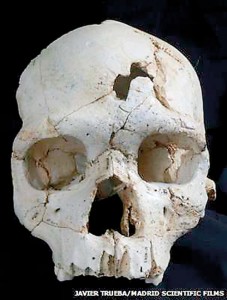Sunday Times 2
Blow after blow: Evidence of 430,000-year-old human violence found
Human remains from a cave in northern Spain show evidence of a lethal attack 430,000 years ago, a study has shown.
Researchers examined one skull from a site called the Pit of Bones, which contains the remains of at least 28 people.
They concluded that two fractures on that skull were likely to have been caused by “multiple blows” and imply “an intention to kill”.
The findings are published in the journal PLOS One.
As well as providing a clue as to why the bodies were in the cave, scientists say the study provides grisly evidence that violence is an intrinsic part of the earliest human culture.
A detailed CT scan of the skull showed that the two fractures were almost indistinguishable
The international research team studied the skull – cranium 17 – using modern medical imaging techniques.
Their virtual reconstruction showed that two clearly visible fractures on its front were almost identical, strongly suggesting, “that both were caused by the same object”.
Lead researcher Dr Nohemi Sala from the Salud Carlos III Institute in Madrid told BBC News: “This individual was killed in an act of lethal interpersonal violence.
“[This is] a window into an often invisible aspect of the social life of our human ancestors.”
The forensic investigation of this ancient death provides a piece in the puzzle of how these people came to be in the cave, which is known in Spanish as Sima de los Huesos.
Violence is culturally mediated and has been with us as long as culture itself has been with usProf Debra Martin, University of Nevada
The site has been studied by scientists for more than three decades. In 2013, researchers were able to extract ancient DNA from one of its preserved bones, leading some experts to suggest that the bodies inside were early representatives of the Neanderthal lineage.
The site continues to be a hot topic for researchers trying to unravel the increasingly complicated story of human origins.
And while this study does not tackle that scientific debate, it suggests that the long vertical shaft of this cave was a place where these ancient people deliberately “deposited deceased members of their social groups”.
The researchers conclude in their paper that this may have been “a social practice among this group”, and may even be “the earliest funerary behaviour in the human fossil record”.
“Intentional interpersonal violence is a behaviour that accompanies humans since at least 430,000 years ago,” commented Dr Sala, “but so does the care of sick or even the care of the dead.”
“We have not changed much in the last half million years.”
Professor Debra Martin is an anthropologist from the University of Nevada, who studies ancient human cultures, including evidence of violence.
She told BBC News that she found the researchers’ conclusions “completely compelling”.
Prof Martin added: “I suspect the farther we push back and find straight up forensic evidence such as these authors have, we will find that violence is culturally mediated and has been with us as long as culture itself has been with us.

